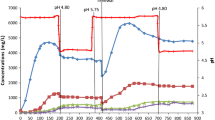Summary
The effect of product gases, H2 and CO2, on solvent production was studied using a continuous culture of alginate-immobilized Clostridium acetobutylicum. Initially, in order to find the optimum dilution rate for aceton--butanol production in this system, fermentations were carried out at various dilution rates. With 10% H2 and 10% CO2 in the sparging gas, a dilution rate of 0.07 h−1 was found to maximize volumetric productivity (0.58 g·l−1·h−1), while the maximum specific productivity of 0.27 g−·h−1 occured at 0.12 h−1. Continuous cultures with vigorous sparging of N2 produced only acids. It was concluded that in the case of continuous fermentation H2 is essential for good solvent production, although good solvent production is possible in an H2-absent environment in the case of batch fermentations. When the fermentation was carried out at atmospheric pressure under H2-enriched conditions, the presence of CO2 in the sparging gas did not slow down glucose metabolism; rather it changed the direction of the phosphoroclastic reaction and as a result increased the butanol/acetone ratio.
Similar content being viewed by others
References
Andersch W, Bahl H, Gottschalk G (1983) Level of enzymes involved in acetate, butyrate, acetone and butanol fermentation by Clostridium acetobutylicum. Eur J Appl Microbiol Biotechnol 18:327–322
Ballongue J, Masion E, Amine J, Petitdemange H, Gray R (1987) Inhibitor effect of products of metabolism on growth of C. acetobutylicum. Appl Microbiol Biotechnol 26:568–573
Brosseau JD, Yan J, Lo KV (1986) The relationship between hydrogen gas and butanol production by C. saccharoperbutylacetonicum. Biotechnol Bioeng 28:305–310
Cata EP, George WL, Finegold SM (1986) Genus Clostridium. In: Sueath PHA, et al (eds) Bergey's manual of systematic bacteriology, vol 2. Williams and Wilkins, Baltimore, pp 1141–1200
Doremus MG, Linden JC, Moreira AR (1985) Agitation and pressure effects on acetone-butanol fermentation. Biotechnol Bioeng 27:852–860
Duffy LE (1988) A novel fermenter design for in-situ extraction of acetone and butanol. Ph D Thesis, Imperial College, University of London, London, UK
Frick C, Schügerl K (1986) Continuous acetone butanol production with free and immobilized C. acetobutylicum. Appl Microbiol Biotechnol 25:186–193
Griffith WL, Compere AL, Googin JM (1983) Novel neutral solvents fermentation. Dev Ind Microbiol 24:347–352
Jones DT, Woods DR (1986) Acetone-butanol fermentation revisited. Microbiol Rev 50:484–524
Kim BH, Zeikus JG (1985) Importance of hydrogen metabolism in regulation of solventogenesis by Clostridium acetobutylicum. Dev Ind Microbiol 26:549–556
Klei HE, Sundstrom DW, Miller JE (1984) Fermentation by Clostridium acetobutylicum under carbon dioxide pressure. Biotechnol Bioeng Symp 14:353–364
Krouwel PG, Groot WJ, Kossen NWF, Vander Laan WFM (1983) Continuous isopropanol-butanol-ethanol fermentation by immobilized growing Clostridium beijerinckii cells in a packed bed fermenter. Enzyme Microb Technol 5:46–54
Leung JCY, Wang DIC (1981) Production of acetone and butanol by C. acetobutylicum in continuous culture using free cells and immobilized cells. Proceedings of the 2nd World Congress of Chemical Engineering, vol 1. pp 348–352
Mollah AH (1991) Continuous acetone-butanol fermentation with gas stripping. Ph D Thesis, Imperial College, University of London, London, UK
Papoutsakis ET (1984) Equations and calculations for fermentations of butyric acid bacteria. Biotechnol Bioeng 26:174–187
Yerushalmi L, Volesky B, Szczesny T (1985) Effect of increased hydrogen partial pressure on the acetone-butanol fermentation by C. acetobutylicum. Appl Microbiol Biotechnol 22:103–107
Author information
Authors and Affiliations
Rights and permissions
About this article
Cite this article
Mollah, A.H., Stuckey, D.C. The influence of H2, CO2 and dilution rate on the continuous fermentation of acetone-butanol. Appl Microbiol Biotechnol 37, 533–538 (1992). https://doi.org/10.1007/BF00240720
Received:
Accepted:
Issue Date:
DOI: https://doi.org/10.1007/BF00240720




